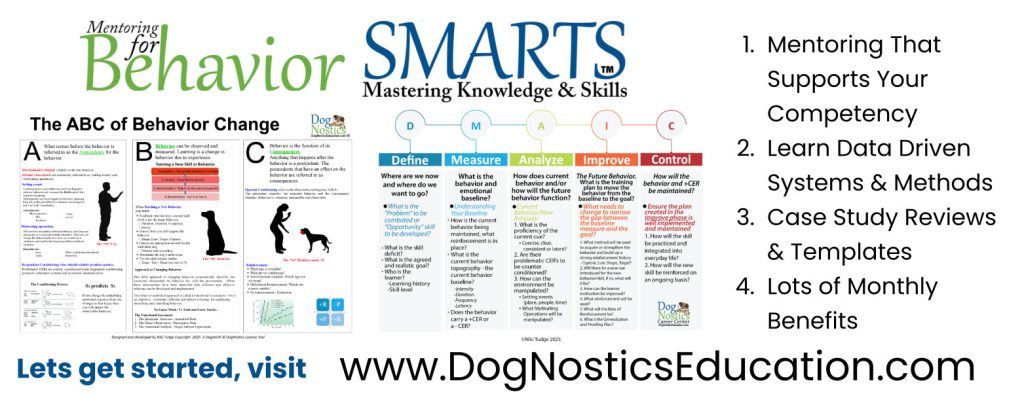Teaching Students, Training Kittens
By Breanna Norris Where to begin training a kitten? We started in the same place we would with any other species, a nose target. I brought a variety of target sticks for students to use…After training nose targets, the students went on to work on crate training, shaping going around a cone, stationing to a platform and cooperative nail trims. The crate training progressed quickly for all four kittens, with Bagheera the star. We started with all four kittens on lab tables (although for other training some teams opted to… Continued
Group Housing Solutions
By Kathie Gregory Horses have evolved as a social species to live in groups. The group is essential to the survival of the species, providing safety in numbers, working together to detect and assess any potential threat. The fact that many horses are now kept in a domesticated environment where there are no predators has not changed their survival mechanism. As such, significant issues arise from a lack of social contact, not being part of a group, and the lack of opportunity to form friendships. It is intrinsic to the… Continued
Considering Canine Aggression from a Scientific Perspective
By Susan Nilson “The skull shape is going to determine the bite level. There’s a lot of stuff that goes into the amount of damage done by a bite and very little of it has to do with the dog’s ability to control himself. A dog jaw is a third order lever. This means the force is in the middle between the load and the fulcrum. This is physics 101. Dogs do not all have the same bite mechanics or bite potential…My issue with bite levels is that predictions are… Continued
Learning from Mother Nature
By Lara Joseph Sadly, behavior issues are skyrocketing in the realm of exotic animal care. Most of what I see is due to ongoing, stressful conditions and, often, the signs of stress are not recognized in the companion animal community or facility staff, who are not always educated appropriately. A lot of the behaviors I see are due to frustration, lack of choice, and the result of an animal not being able to control their own consequences. Read article
Saying Goodbye
By Alicia Obando According to Tzivian et al. (2015), the loss of a pet may be “very stressful to the owner, whether these deaths were caused by euthanasia, accident, or by the progress of illness. The longer one has a pet, the greater the attachment can become, and this strong attachment may provoke a distress reaction upon a pet’s death. Many people grieve for their pets in much the same way as they do for the deaths of their friends. Families are known to experience a range of emotions in… Continued
Dealing with Dog Bite Liability
By David Pearsall As most pet professionals are aware, a general liability policy will protect you against bodily injury or property damage to others caused by your negligence (or your staff’s negligence while working for your business). Typically, a $1,000,000 liability limit is recommended. Please be aware that under most general liability policies, defense cost is outside of this limit, and the insurance company will defend you if a lawsuit is brought against you/your business. There is also a medical payments limit (typically $5,000 – $10,000) which is used to… Continued
Teaching Your Dog to “Go Say ‘Hi'”
By Danette Johnston I am not a fan of dogs greeting on leash for several reasons but I do like to teach dogs a “GO SAY HI” cue for the following circumstances: Times when it may be OK for the dogs to meet on leash. For emergencies when another dog or human is approaching without consent. Therapy work. GO SAY HI is a bit of a fake-out cue. What GO SAY HI means to me (and my dogs) is: go ahead and step toward that dog/human, sniff for 1-2 seconds and then come back… Continued

June 18, 2019: New Study Examines Evolution of “Puppy Dog Eyes”
A new study has found that facial musculature between domestic dogs and gray wolves differs only around the eye. The study reports that exaggerated eyebrow facial movements in dogs cause their eyes to “appear larger, giving the face a more paedomorphic, infant-like appearance, and also resembles a movement that humans produce when they are sad.” This potentially elicits a “caregiving response from humans, giving individuals that inherit the trait a selection advantage with humans.” The researchers conclude that “the data suggest that selection—perhaps mainly unconscious—during social interactions can create selection pressures… Continued
Are Head Halters Like Prongs?
By Yvette Van Veen Are Head Halters Like Prongs? Head halters took the training world by storm years ago. Some trainers are hanging up their head halters because they simply don’t like how dogs seem to fight them. Other trainers, those who use force have long tried to make the claim that head halters are no different from prong collars. Generally, the argument made is that if you use a head halter then you really are no different from a trainer who uses prong collars. That we are in denial. That aversives are necessary. That we… Continued
Animal Trainers: Take Animal Emotions into Consideration!
By Karolina Westlund Ph.D. of PPG corporate partner Illis Animal Behaviour Consulting Is the dog fearful, or crouching? Does it matter, when you’re training? The world of animal trainers is divided, and I find that some trainers avoid the subject of animal emotions altogether. “There’s no need to factor in and understand emotions, just deal with the observable behaviour”, is the gist of what some trainers and animal professionals say. No doubt their unwillingness to consider emotions stems from the Father of Behaviourism, influential to this day. Skinner said: “The ‘emotions’ are excellent examples… Continued

June 5, 2019: NY Legislature Votes to Ban Declawing in Cats
New York lawmakers have passed a bill sponsored by Linda Rosenthal (D-Manhattan) to ban cat declawing, meaning New York State is set to become the first to outlaw the procedure. The State “joins several cities in banning declawing, including Los Angeles and Denver; several other states, including California, New Jersey and Massachusetts, are also considering bans, according to the Humane Society of United States, which hailed the New York bill.” Read article

May 31, 2019: Manitoba Vets Vote to Ban Declawing
Manitoba has become the sixth Canadian Province to ban the practice of declawing cats, a procedure that amputates the first joint of a cat’s toes. Newfoundland and Labrador and Alberta banned the practice earlier this year, while British Columbia, Prince Edward Island and Nova Scotia prohibited it in 2018. New Brunswick is expected to join them in July. Read article
Behavior Suppression Is Not the Same as Behavior Modification
By Jenny Efimova Reactive behavior is the tip of the iceberg. It’s what we see: the lunging, the barking, the snarling, the growling, etc. It’s what’s above the surface and it’s what we often want to stop. What we don’t see and what’s driving this behavior is the rest of the iceberg below: the fear, the anxiety, the stress, the frustration. So if we want the behavior to change, we need to look at the root cause, not just the symptoms. When we change how a dog feels about a… Continued

May 16, 2019: Australian Capital Territory Overhauls Animal Welfare Legislation
Under the legislation, “[p]et shops and boarding kennels will be licensed and all pets recognised as ‘sentient beings with intrinsic value’.” In addition, confining an animal, “or even transporting it in a way which causes it injury, pain or stress, will attract a maximum penalty of $16,000 and a year’s imprisonment. An identical penalty will apply for anyone who places an electric shock device on an animal, such as a shock collar.” Read article
Helping Pet Families in Need
By Alicia Obando I had become quite familiar and active with the pet care and rescue organizations around my city of Chicago, Illinois. I saw that there were lots of organizations helping find homes for homeless pets. This was great work done by mostly unpaid, hard-working volunteers. Even though so many of us were working towards this cause of helping homeless pets, it seemed like it would be a never ending battle. I started thinking that maybe instead of helping the animals once they became homeless, I should try to help… Continued
Humane Education
By Stephanie Peters Humane programs that incorporate animal interaction have a profound capacity to help students on a personal level. Angel Banuelos-Price is a fifth grade teacher at Boone Middle School and she has enthusiastically welcomed my educational programs with Marmalade from the very beginning. She observes that Marmalade’s presence in her classroom reduces her students’ stress and anxiety levels, and that her attendance numbers are often higher on the days when Marmalade visits the classroom. Stacy Lehman of University Community Childcare in Ames also notes the social-emotional benefits to her… Continued
Stable Life
By Kathie Gregory In the equine world, I would say it is widely accepted that a horse may live the majority of his life in a stable, and, in my opinion, there is far less awareness concerning the impact this may have on his wellbeing. People may consider it “normal” for a horse to spend most of his time in the stable and only be brought out to do his job or to be given specific exercise subject to people’s requirements…There are numerous studies on the adverse effects of keeping horses… Continued
The “Ouch” You’ll Never Hear
By Andrea Carne …according to Bahr (2017), up until recently “it was thought cats did not experience pain at all, based purely on the fact that they tend not to show it.” In my opinion, it is safe to assume this is a major factor behind why chronic pain caused by conditions like arthritis go undiagnosed and, therefore, untreated in many older cats. This is despite several studies showing that arthritis is the number one cause of chronic pain in cats and that 90 percent of cats over the age… Continued
From Foes to Friends
By Tori Ganino By the end of the second week and into the beginning of the third week since arriving at our home, Jeter was spending more time out of his room. He stayed on leash and chose my bed to be one of his favorite places to relax. One evening, Si entered the room, and with Jeter’s presence on the bed unbeknownst to him, jumped on the bed and the two were suddenly nose to nose. I immediately gave Jeter the “leave it” cue which he followed. Si jumped off… Continued
A Better Awareness of Overarousal
By Anna Bradley When mentioning “arousal” or “overarousal,” dog owners may have some idea as to their definition, but in my experience the consensus seems to be that the terms generally refer to negative trigger events. This is inaccurate, however. Arousal triggers include positive as well as negative events. Examples of positive arousal triggers may include greeting a familiar person, getting the leash out, engaging in a dog sport, or play. Examples of negative arousal triggers may include an unfamiliar person approaching the home, or going to the vet. Each dog… Continued
Busting the Muzzle Myth
By Rachel Brix Walking the busy streets of our small tourist town with my dog, the looks on people’s faces range from confusion, to disgust, to laughter, to disapproval, to openmouthed, wide-eyed shock. The cause? Just a dog wearing a muzzle. Let’s face it, we don’t see too many dogs in public wearing what looks, to some people at least, like some sort of medieval torture device. And when people who are not dog professionals see us, they may draw the conclusion that I’m mean, that my dog is dangerous, or something… Continued
From Zero to Hero
By Ariel Baber A lot of people may get annoyed when a dog wakes them up, particularly if they are woken up by him pawing at their chest and licking their face. To be honest, I’m no different. I had no idea that night why Halligan (whose registered name is Zero to Hero) was insisting I get up when he normally sleeps as long as I do. Nevertheless, I begrudgingly got up and began our normal routine of feeding him first, then checking my blood sugar and eating breakfast. It… Continued
Dog Tired? When Exercise Wakes him Up Rather than Tires Him Out!
By Sue McCabe Many years ago, at a seminar in Edinburgh, I heard Patricia McConnell say that most dog walks wake the dog up, rather than tire the dog out. ‘But why is he not tired?’ I’m often asked. ‘I’ve taken him for a really long walk.’ We’re just back from a 10km walk followed by a sandwich in the sun. A good brisk march with plenty of variation from sniffing and fetching, meeting and greeting dogs and even swimming. Despite this apparent morning of stimulation, after we arrived home, Jellybean… Continued
How to Make the Transition to Full-Time Dog Pro
By Veronica Boutelle of PPG corporate partner, dogbiz If your dream is to work with dogs for a living but you’re still toiling full time outside the dog industry, or juggling a part-time business alongside your “real” job, you need a transition plan: A plan to get you from where you are now to working full-time in your own dog training or dog walking business. Here’s what should go into yours: Determine feasibility. Feasibility is a comparison of revenue to expenses. Is your business set up to make what you… Continued
« Previous 1 … 16 17 18 19 20 … 27 Next »


